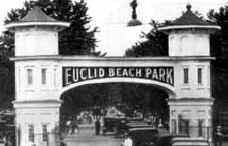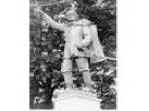The First 25 Years: 1923 - 1948
 The year was 1923 and big news in town was the construction of the Cleveland Union
Terminal right on Public Square. Cleveland was then the 6th largest city in the
nation. Among the nearly 800,000 Clevelanders were 35,000 Polish-Americans, many of who
were already established in business, the professions and government.
The year was 1923 and big news in town was the construction of the Cleveland Union
Terminal right on Public Square. Cleveland was then the 6th largest city in the
nation. Among the nearly 800,000 Clevelanders were 35,000 Polish-Americans, many of who
were already established in business, the professions and government.
The Polish National Alliance (PNA) noted the emergence of this group of educated, successful and influential men and sent Marion Kudlick to recruit them for the PNA. Among those he approached were Stanley Olstyn, Joseph Sawicki, Felix and Walter Matia and Boleslaw Majewski.
These men were to be among the founding fathers of the Cleveland Society Lodge of the PNA, which first met in that year of '23 at the Polish National Alliance Home on Fullerton Avenue on Cleveland's Southeast Side. Among the Society's primary orders of business was to elect Felix Matia their first president.
Although differences in policy led the Society to sever ties with the PNA by the late '20's the organizations' strong foundations guaranteed it a viable future. Meetings were moved between a number of the city's fashionable hotels of the era including the Olmstead, Cleveland and Winton...all bastions of a by-gone day of luxury and elegance.
A sense of fun, as evidenced by the number of excursions, conventions and parades, was part of the over-all proceedings. A sense that included the adoption of the Red Fez as an emblem of membership.
Although the headgear may have seemed frivolous, the campaigning for elective office in the Society was anything but. Election meant recognition as a leader in the Polish community so slogans, banners, door-to-door campaigning and elaborate victory parties all became a yearly tradition.
Another tradition was the annual Orphan's Picnic. Caravans of horn-tooting
 cars would bring the children for a day of merriment to places they might never go otherwise,
such as one of the favorites of the time, Euclid Beach Park. It was, then as now, part of the
Society's on-going commitment to the community.
cars would bring the children for a day of merriment to places they might never go otherwise,
such as one of the favorites of the time, Euclid Beach Park. It was, then as now, part of the
Society's on-going commitment to the community.
With the Great Depression came an equal slump in the membership of the Cleveland Society. High-minded goals not withstanding, monthly membership dues that previously were thought to be a pittance became a luxury. The once popular dances held at hotels throughout downtown saw fewer and fewer Society members ready to trip the light fantastic.
Yet even with the decline in both members and social activities these darkest of days saw an enlightened leadership that was to provide the most brilliant accomplishment in the first 25 years of the organization.
 Under the leadership of Judge Felix Matia, Judge Joseph Sawicki and Mr. Stanley Olstyn the Society
financed the establishment of the Polish Cultural Garden in Rockefeller Park. A monument that still
stands as testament to their progressive vision. Pictured here is the re-sculpted bust of Copernicus
from the Gardens.
Under the leadership of Judge Felix Matia, Judge Joseph Sawicki and Mr. Stanley Olstyn the Society
financed the establishment of the Polish Cultural Garden in Rockefeller Park. A monument that still
stands as testament to their progressive vision. Pictured here is the re-sculpted bust of Copernicus
from the Gardens.
The end of the depression had the same mixed impact on the Society as it had on America overall. Joblessness was a thing of the past but part of the economic fuel was war.
It was in the early years of World War ll that a dynamic group of young men began to play a more active role in the shaping and running of the organization. Among them were John Puzenski, Ben Stefanski (Senior) and Walter Grabski.
As a tribute to the job they were doing for our country both at home and overseas the sons and daughters of members were invited to attend the annual Christmas dances during the war years.
The fact that so many of the members, their children and grand children had
 volunteered for military service was no surprise. It was a part of the tradition that has always had
brave Poles ready to lay down their lives for the country they love. A tradition that includes men
like Tadeusz Kosciuszko whose role in the war for America's independence is memorialized at
Cleveland's nationally renowned Art Museum.
volunteered for military service was no surprise. It was a part of the tradition that has always had
brave Poles ready to lay down their lives for the country they love. A tradition that includes men
like Tadeusz Kosciuszko whose role in the war for America's independence is memorialized at
Cleveland's nationally renowned Art Museum.
At war's end the ranks of the Cleveland Society of Poles began to swell. Veterans, young technicians and engineers were encouraged to join, again with an eye toward the kind of leaders it would take to insure the future of the organization.
In 1948, as the Society celebrated its' first 25 years, the membership stood at 144. A group of dedicated and visionary men, many of who represented some of Cleveland's most prominent Polish-American families.
back to top